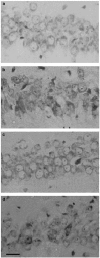Capsaicin exhibits neuroprotective effects in a model of transient global cerebral ischemia in Mongolian gerbils
- PMID: 15678080
- PMCID: PMC1576053
- DOI: 10.1038/sj.bjp.0706115
Capsaicin exhibits neuroprotective effects in a model of transient global cerebral ischemia in Mongolian gerbils
Abstract
1. Capsaicin, the irritant principle of hot peppers, is a vanilloid agonist known to activate the transient receptor potential channel vanilloid subfamily member 1 (VR1), recently reported to be involved in neurodegeneration. The present study investigated the role of VR1 in a model of global cerebral ischemia in gerbils. 2. Over the dose range tested, capsaicin (0.01, 0.025, 0.05, 0.2 and 0.6 mg kg(-1)), given 5 min after recirculation, dose-dependently antagonized the ischemia-induced electroencephalographic total spectral power decrease and restored relative frequency band distribution evaluated 7 days after ischemia. 3. Capsaicin, at all tested doses, fully prevented ischemia-induced hyperlocomotion evaluated 1 day after ischemia. 4. Capsaicin dose-dependently antagonized ischemia-induced memory impairment evaluated in a passive avoidance task, 3 days after ischemia. 5. Capsaicin showed a dose-dependent hypothermic effect evaluated for 2 h after recirculation. 6. At 7 days after ischemia, a progressive survival of pyramidal cells in the CA1 subfield in capsaicin-treated gerbils, with a maximum of 80%, at a dose of 0.2 mg kg(-1), was obtained. 7. The selective VR1 antagonist, capsazepine (0.01 mg kg(-1)), reversed capsaicin-induced protective effects, in a competitive manner. 8. These results suggest that the neuroprotective effect of capsaicin may be attributable, at least in part, to VR1 desensitization and provide a valuable target for development of interventional pharmacological strategies.
Figures






Similar articles
-
Vanilloid VR1 receptor is involved in rimonabant-induced neuroprotection.Br J Pharmacol. 2006 Mar;147(5):552-9. doi: 10.1038/sj.bjp.0706656. Br J Pharmacol. 2006. PMID: 16444289 Free PMC article.
-
[The protective effects of melatonin on global cerebral ischemia-reperfusion injury in gerbils].Yao Xue Xue Bao. 2002 May;37(5):329-33. Yao Xue Xue Bao. 2002. PMID: 12579834 Chinese.
-
Protective effects of iptakalim, a novel ATP-sensitive potassium channel opener, on global cerebral ischemia-evoked insult in gerbils.Acta Pharmacol Sin. 2006 Jun;27(6):665-72. doi: 10.1111/j.1745-7254.2006.00356.x. Acta Pharmacol Sin. 2006. PMID: 16723083
-
Current perspectives on the therapeutic utility of VR1 antagonists.Curr Med Chem. 2004 Dec;11(24):3185-202. doi: 10.2174/0929867043363686. Curr Med Chem. 2004. PMID: 15579007 Review.
-
Protective Role of Capsaicin in Neurological Disorders: An Overview.Neurochem Res. 2022 Jun;47(6):1513-1531. doi: 10.1007/s11064-022-03549-5. Epub 2022 Feb 12. Neurochem Res. 2022. PMID: 35150419 Review.
Cited by
-
Transient receptor potential channels in the vasculature.Physiol Rev. 2015 Apr;95(2):645-90. doi: 10.1152/physrev.00026.2014. Physiol Rev. 2015. PMID: 25834234 Free PMC article. Review.
-
Protective effect of hot peppers against amyloid β peptide and brain injury in AlCl3-induced Alzheimer's disease in rats.Iran J Basic Med Sci. 2023 Mar;26(3):335-342. doi: 10.22038/IJBMS.2022.67871.14845. Iran J Basic Med Sci. 2023. PMID: 36865040 Free PMC article.
-
Effect of combined extracts of aged garlic, ginger, and chili peppers on cognitive performance and brain antioxidant markers in Aβ-induced rats.Exp Anim. 2020 Aug 5;69(3):269-278. doi: 10.1538/expanim.19-0123. Epub 2020 Feb 11. Exp Anim. 2020. PMID: 32051390 Free PMC article.
-
Short-term increases in transient receptor potential vanilloid-1 mediate stress-induced enhancement of neuronal excitation.J Neurosci. 2014 Nov 12;34(46):15369-81. doi: 10.1523/JNEUROSCI.3424-14.2014. J Neurosci. 2014. PMID: 25392504 Free PMC article.
-
TRPV1: a stress response protein in the central nervous system.Am J Neurodegener Dis. 2012;1(1):1-14. Epub 2012 Apr 1. Am J Neurodegener Dis. 2012. PMID: 22737633 Free PMC article.
References
-
- ARAKI H., NOJIRI M., KAWASHIMA K., KIMURA M., AIHARA H. Behavioral, electroencephalographic and histopathological studies on mongolian gerbils with occluded common carotid arteries. Physiol. Behav. 1986;38:89–94. - PubMed
-
- BICKLER P.E., FAHLMAN C.S. Moderate increases in intracellular calcium activate neuroprotective signals in hippocampal neurons. Neuroscience. 2004;127:673–683. - PubMed
-
- BRAIDA D., PEGORINI S., ARCIDIACONO M.V., CONSALEZ G.G., CROCI L., SALA M. Post-ischemic treatment with cannabidiol prevents electroencephalographic flattening, hyperlocomotion and neuronal injury in gerbils. Neurosci. Lett. 2003;346:61–64. - PubMed
-
- BRAIDA D., POZZI M., SALA M. CP 55,940 protects against ischemia-induced electroencephalographic flattening and hyperlocomotion in Mongolian gerbils. Neurosci. Lett. 2000;296:183–191. - PubMed
-
- BROOKS J.W., PRYCE G., BISOGNO T., JAGGAR S.I., HANKEY D.J., BROWN P., BRIDGES D., LEDENT C., BIFULCO M., RICE A.S., DI MARZO V., BAKER D. Arvanil-induced inhibition of spasticity and persistent pain: evidence for therapeutic sites of action different from the vanilloid VR1 receptor and cannabinoid CB(1)/CB(2) receptors. Eur. J. Pharmacol. 2002;439:83–92. - PubMed
Publication types
MeSH terms
Substances
LinkOut - more resources
Full Text Sources
Other Literature Sources
Medical
Miscellaneous

